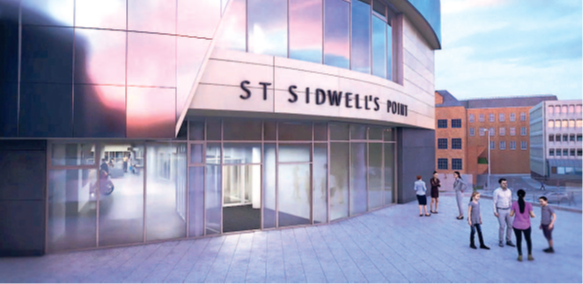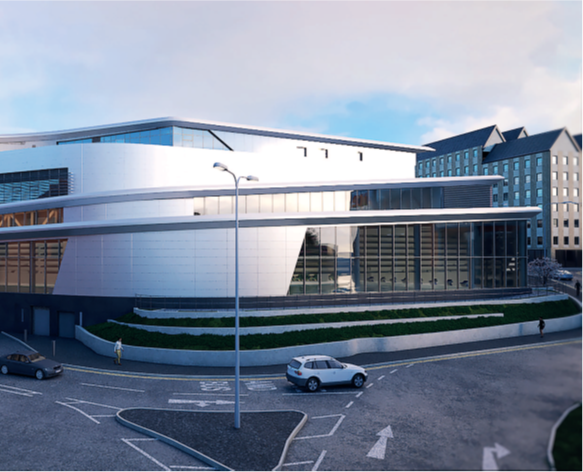
Due to open this year, St Sidwell’s Point will be the first leisure facility in the UK built to the super energy efficient Passivhaus standard.
ST Sidwell’s Point aims to be one of the most energy efficient leisure centres in the world. Located in the city centre, the new leisure centre is being built alongside the new Exeter Bus Station, both of which have been funded by the city council.Designed by Space and Place Architects, the complex replaces the aging Pyramids swimming pool deemed difficult and expensive to upgrade to modern standards. Exeter City Council are working with main contractor Kier on the complex. Spread over four floors on a tight urban site, the centre will form an anchor within a new commercial retail masterplan and will act as a gateway building on one of the main approaches into the city. The complex is expected to attract at least 500,000 visits a year with a range of facilities, including an eight lane main swimming pool and a four lane pool for learners, both with moveable floors, as well as a confidence water pool and a 100 seat spectator seated area. Other facilities will include 150 station fitness gym and two fitness studios, health suite and spa facility, children’s soft play area and a café seating 50.

stringent build
S&P adopted a holistic approach to the space design which included orienting the pool hall glazing southwards to maximise solar gain, an orientation the University of Exeter believes will work best under future climate scenarios. By contrast, the dry areas of the centre work best with north facing glazing as they are more likely to overheat in summer. S&P’s spatial planning considered this together with the relative temperature of adjacent rooms and actively reduced heat loss by minimising the adjacency of high and low temperature rooms. Use of simultaneous heating and cooling air-source heat pumps also means that hot air from the gym and studios can be used to offset heat loss in the pool area – a major source of expense.The pool filtration system is another UK first – using ceramic microfiltration exceptionally high levels of filtration occur. UV light acts as the main water decontaminant thereby substantially reducing the use of chemicals and the impact on the environment. The building also contains a Faraday Cage around the children’s crèche to protect them from electromagnetic fields.The building has been modelled to withstand predicted changes in climate conditions up to 2080. It is expected to save up to 70 per cent on annual energy costs in comparison to lower efficiency building techniques, with a 50 per cent reduction in water use. Other benefits include outstanding internal water and air quality, excellent daylight levels and lower maintenance costs due to a high-quality building fabric.Passivhaus-certified AA100 capped curtain walling from Kawneer has been used around the building envelope and some locations internally, as well as RT82HI windows which feature exceptional levels of thermal performance and airtightness, partly due to larger-than-normal thermal breaks.These Passivhaus-certified products are being installed alongside Kawneer's AA100 FR and AA720 FR fire-rated curtain walling and doors as internal screens, AA190 TB external entrance doors, AA720 standard and AA720 HI doors internally and externally, and AA130 brise soleil.In order to achieve the stringent build criteria, Kier has worked closely with its subcontractors to deliver a ‘Passivhaus Passport’ training scheme, equipping its staff with the knowledge and skills to meet the requirements.
fighting climate change
The bespoke commercial Passivhaus centre is expected to open to the public this summer, forming part of a £300m city centre vision from the council, which will also see housing, offices, restaurants, and retail, as well as the possibility of a new multi-use entertainment venue.Fighting climate change is firmly placed at the top of the city council’s agenda with Exeter’s ambition of creating a Net Zero Carbon city by 2030 sitting at the heart of everything the council does going forward, said council leader Phil Bialyk last year.Appointing deputy leader Rachel Sutton as lead councillor for Net Zero Exeter 2030, Cllr Bialyk said putting Net Zero Exeter 2030 at the top of the council’s corporate priorities was the best possible position to continue its economic recovery from the Coronavirus crisis.“Last year we declared a Climate Emergency here in Exeter and we have been doing a lot of work with our partnersbringing forward a lot of policy papers. Now we have to start putting some of that into action if we are to achieve a Net Zero Carbon Exeter by 2030.”He said a portfolio dedicated to lowering carbon emissions and fighting climate change has been created for the first time.“We’ve got a lot of plans – the buildings that we are creating here in Exeter are to Passivhaus standards, reducing carbon by up to 90 per cent and reducing the bills for households.”As part of the plans, the council will also retrofit existing properties across the city to be highly energy efficient and low carbon.